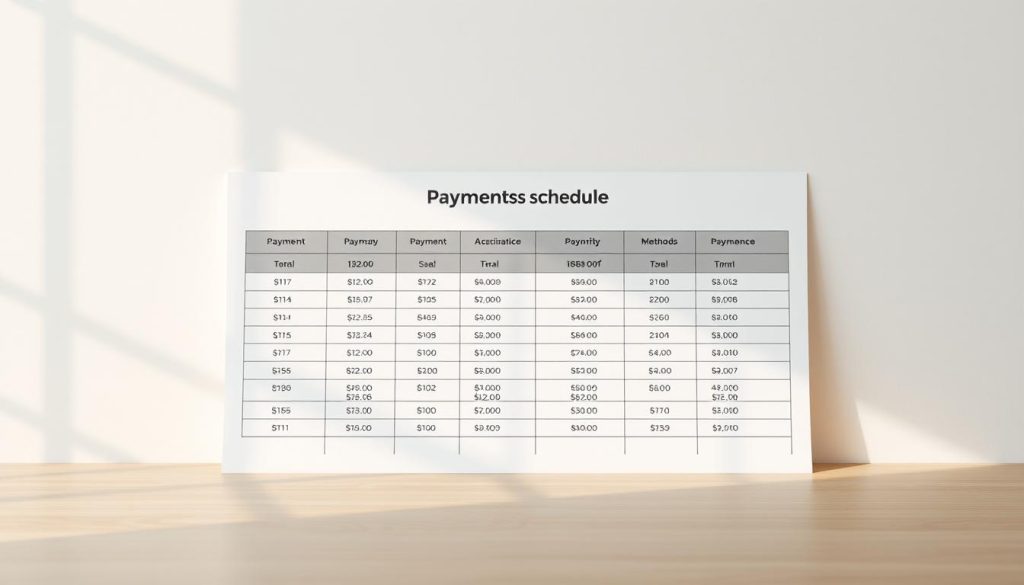Your payment rules are the guardrails that keep your business healthy and help you get paid reliably. Clear clauses in a contract show when and how funds arrive, what methods are accepted, and whether deposits or late fees apply.
Common schedules like Net 7 or Net 30 and milestone-based invoicing make expectations concrete. Deposits protect your cash flow on larger projects and lower risk for both clients and the person doing the work.
Simple options—bank transfer, card, or digital wallets—remove friction so clients pay faster. Well-written terms also allow you to charge interest or pause services if payments are late, which improves business stability.
This short guide breaks down each element, with examples and practical choices you can use to make sure every invoice aligns with the contract. Small changes can reduce admin, steady your revenue, and help you get paid on time.
Table of Contents
Key Takeaways
- Define schedules: use Net 7, Net 30, or milestones to set clear due dates.
- Ask for deposits to protect time and reduce risk on bigger projects.
- Offer easy methods like bank transfer or cards to speed up payments.
- State late fees clearly so you have a contractual basis to act.
- Automate invoices and reminders to cut unpaid invoices and admin time.
What are freelance payment terms and why they matter today
Clear rules about who pays what, when, and how turn verbal agreements into reliable cash flow.
These clauses in a contract set your fixed fee or hourly rate, invoice timing, deposits, early discounts, accepted method and currency, and steps for late accounts. They say when you will send invoices and how many days a client has to settle them (for example, Net 30).
Well-drafted language helps your business forecast revenue and protect against slow or missed payments. It also makes the invoicing workflow easier: quotes offer the price, purchase orders confirm client approval, and invoices request the actual funds with due dates and amounts.
Good practice is to have these points agreed upon before a project starts. That reduces disputes, speeds approvals, and keeps services running on schedule.
- Specify rates, invoice cadence, and a clear payment schedule.
- List accepted methods (bank transfer or card) and the currency.
- Describe consequences for non-payment, such as late fees or paused work.
Choose the right payment model for your project and client
Pick a billing structure that matches the scope, risk, and timeline of each project.
Fixed-price agreements for clear scopes
Use a fixed-price when deliverables, acceptance criteria, and deadlines are clear. This option helps clients budget and keeps invoices predictable.
Time-based billing with hourly or daily rates
Hourly or daily rates work best when the scope may change or the work is research-heavy. Track hours and invoice at set intervals so you can get paid for actual effort.
Milestone payments that track progress
Break large projects into phases like discovery, design, and launch. Each milestone ties a deliverable to a schedule and a payment event.
Upfront payment for full project security
For small, fast-turnaround jobs, ask for full payment up front to reduce admin and secure revenue.
Fifty-fifty split: deposit at start, balance on completion
A 50/50 split balances risk. A deposit secures the kickoff and the final release links to delivery and approval.
Retainer agreements for ongoing work
Retainers lock in monthly or quarterly fees for continuous service or availability. They smooth cash flow and build steady client relationships.
Decision tip: If scope is crystal clear, choose fixed-price; if it may shift, use hourly; for long work, use milestones.
Document the chosen model in the contract in plain language, and add a deposit for larger projects or when you bring collaborators. Test different options across clients to find what helps you get paid on time.
How to set your payment schedule, methods, deposits, and late fees
Set a clear billing rhythm so you and your clients know when invoices are issued and when funds are due. Pick an option that fits the project and your cash needs.
Payment schedule options
Common schedules include Net 7, Net 30, Net 60, End of Month (EOM), or due on receipt. Offer an early-pay incentive like « 10% 15 Net 30 » when faster cash helps your business.
Payment methods clients can use
List accepted channels on every invoice: bank transfer, card, wire, check, or digital wallets. Clear choices reduce friction so clients pay without extra emails.
Using deposits to secure time and cash flow
For larger projects, require a deposit—commonly 20–50%—to hold your schedule. State if a deposit is non-refundable and how it applies to the final invoice in the contract.
Late payment clauses
Include a late payment clause that sets interest or fees (1–5%) and the number of days before charges apply. Also reserve the right to suspend services if accounts remain overdue.
Quick checklist:
- Match every invoice to the agreed schedule and methods.
- Use a clear deposit clause for new or large projects.
- State late fees and suspension rights to protect paid time.

Freelance payment terms to include in your contracts
Spell out billing rules in the agreement so both sides can plan and avoid surprises. Use plain language that shows what you will deliver, how you will bill, and when clients must act.
Scope and fees: List deliverables, acceptance criteria, and either a fixed fee or hourly/daily rate. State the currency and how extra work will be handled.
Invoicing cadence and due dates: Say when you will issue invoices (start, milestones, monthly, or on completion) and use clear within days language like Net 30 so finance teams can route approvals.
Deposits, partial refunds, and cancellation: Specify deposit amount, refund policy, and how partial payments apply to final invoices. This reduces dispute risk and clarifies expectations.
Methods, PO numbers, and late payment: Name accepted methods and require PO numbers if the client needs them. Add a late payment clause that allows interest, fees, and the right to pause service after stated days.
How to get paid checklist:
- What you send and when (invoice, PO, milestone).
- Accepted methods and currency on every invoice.
- Deposit rules and late fee trigger days.
For ready-to-use language and invoice examples, see our invoice templates and best practices.
Build invoice-ready terms that help you get paid on time
Create invoice-ready language that mirrors how and when work is delivered so clients can approve and pay without delay.
When to issue invoices and how to align with your schedule
Decide whether to bill at kickoff, at milestones, monthly, or on completion. Match invoice timing to the project schedule in your contract.
Essential invoice details: PO numbers, milestones, and payment due
Each invoice should list amounts owed, taxes, due dates, and the exact method to pay. Add PO numbers when required and reference milestones like “Milestone 2: Wireframes approved.”
Early-payment discounts and clear late fee reminders
Include an early-pay example such as “10% 15 Net 30” to speed receipts. Add a short late payment reminder and state the days after which fees apply.
- Use invoicing tools with automatic reminders and client portals.
- Offer multiple methods—bank transfer, card, or wallet—to reduce friction.
- Track paid time and expenses so each invoice is accurate and defensible.
How to communicate and negotiate payment terms with clients
Start discussions about billing early so expectations are clear before work begins.
Share key payment terms alongside your pricing in the proposal. This helps clients see the schedule, methods, and due dates before they sign.
Share terms early alongside pricing to set expectations
Use a short, friendly paragraph in the proposal that lists deposit amounts, milestone dates, and accepted methods. Make sure every document repeats how to pay.
Balance client processes with your cash-flow needs
Ask about client procurement timelines. If approvals slow the cycle, negotiate a deposit or shorter invoices so your business keeps steady cash.
Template language that keeps negotiations professional
Keep phrases simple: state a minimum deposit, maximum Net days, and one or two options like milestones or retainers. Confirm any changes in the contract so agreed points become enforceable.
- Offer multiple payment options to reduce delays and help you get paid faster.
- Use friendly templates and recap final terms in a welcome email at project start.

Handling late payments and non-payment professionally
When invoices run late, a calm, consistent process keeps relationships intact and cash flowing.
Start with automation: set reminders before and after due dates so clients get multiple prompts to settle an invoice. Automated notices remove friction and reduce forgotten balances.
Follow-ups, phone check-ins, and a clear cure path
If an invoice becomes overdue, send a polite follow-up email. If you get no response, make a brief phone check-in to confirm status and next steps.
Apply late fees and pause services per the contract
Include a late payment clause with interest and the right to suspend service if an account stays unpaid beyond the grace period. In the UK, statutory default interest is 8% plus the Bank of England base rate; many contracts use about 4% over base instead.
Escalation and documentation
Keep all emails, call notes, and updated invoices in one place. Offer a short cure window (for example, 7–14 days) before formal notices. If delays persist, escalate to formal letters or collections.
| Action | When | Why it helps |
|---|---|---|
| Automated reminders | Before & after due date | Reduces forgetfulness and admin |
| Phone check-in | Within 7 days overdue | Clarifies issues quickly |
| Apply clause & pause | After grace period | Protects time and cash |
| Formal escalation | 30+ days overdue | Enforces collection options |
Tools and workflows that make freelance payment secure and simple
Modern platforms stitch proposals, schedules, and invoices into one smooth workflow that saves time.
Integrated features connect a signed proposal to an automated billing schedule. That means deposits, recurring invoices, and reminders follow without copy/paste.
Streamline proposals, schedules, and invoicing
Turn offers into invoices automatically and enable client-side portals where clients can view docs and pay in one place.
Deposits, recurring billing, and balance tracking
Request partial deposits on invoices. Let the system recalculate balances and due dates when a client makes a partial payment.
Gateways, methods, and faster receipts
Enable multiple payment methods—card, bank transfer, or wallets—and add one-click payments to shorten cycles. Capture POs, attach receipts, and track paid time and expenses inside the same tool so invoices match scope and rates.
« Start small: automate reminders first, then add auto-billing and portals as you scale. »
- Use integrated tools to link proposals, schedules, and invoicing.
- Turn on automatic reminders to nudge clients and reduce admin for your business.
- Set recurring invoices for retainers to help you get paid on predictable dates.
- Offer gateways that accept multiple methods so clients choose what works best.
For management guidance and platform choices, see our management tools.
Conclusion
End by locking down easy, enforceable rules that protect your time and steady your cash flow.
Clear, friendly, and firm terms help freelancers get paid and keep projects on track. Choose a model that fits each project—fixed, hourly, milestone, upfront, 50/50, or retainer—and document it in the contract.
Make sure every invoice matches the contract with due dates, methods, and references. Require a deposit when risk is higher and offer simple methods like online card or bank transfers to reduce friction.
Start small: try Net 30 plus a deposit or enable card payments and automated reminders. Use tools that automate invoices, track payments, and provide client portals so you spend less time chasing and more time on work.
Review and refine your approach each quarter to keep systems aligned with clients and growing projects. For model clauses and example language, see our clear contract language.
FAQ
What should be included in a secure payment agreement?
Include a clear scope of work, a stated rate or fixed fee, the currency, invoice frequency, and accepted methods like bank transfer, credit card, wire, or digital wallets. Add a deposit amount, milestone schedule, due dates using « within X days, » and late-fee or service-suspension clauses to protect cash flow.
How do I choose the best pricing model for a project?
Match the model to the work. Use fixed-price for well-defined scopes, hourly or daily billing for open-ended work, milestone payments for staged delivery, retainers for ongoing services, or an upfront payment if you need full security. Choose what balances client expectations and your financial needs.
What are common billing schedules I can use?
Standard options include due on receipt, Net 7, Net 30, Net 60, or end-of-month (EOM). Pick a schedule that suits your cash flow and be explicit in the contract and on invoices—state « within 14 days » or another clear timeframe so clients know when to pay.
How much deposit should I request before starting work?
Deposits vary by risk and project size. Typical ranges are 20–50% for most projects; 100% may be appropriate for small or one-off pieces. State whether the deposit is refundable and link it to a cancellation policy to avoid disputes.
When should I use milestone payments?
Use milestones for multi-stage projects or deliverables that can be reviewed. Tie payments to tangible outputs—design drafts, alpha builds, or final deliverables—to keep cash flow steady and reduce the chance of nonpayment after full delivery.
Which payment methods should I offer clients?
Offer a mix: bank transfer/ACH, credit or debit card, wire for international work, and popular digital wallets or payment gateways like PayPal, Stripe, or Square. Multiple options reduce friction and speed up collection.
How do I set and enforce late fees?
Add a late fee clause with a flat fee or interest (for example, 1.5% per month) and state when it applies. Include a grace period if desired. Enforce fees consistently and reference the clause in reminders to encourage prompt payment.
What details make an invoice "invoice-ready"?
Include your business name and contact, client name, invoice number, issue and due dates, PO number if provided, detailed line items or milestone references, the total due, accepted methods, and payment instructions. Clear invoices speed up approval and payment.
Can I offer early-payment discounts?
Yes. Common terms are 1–2% off if paid within 7–10 days (for example, 2/10 Net 30). Offer discounts selectively to improve cash flow, but calculate margins first so discounts don’t erode profitability.
How should I communicate terms to new clients?
Share your terms with proposals and before work begins. Present them in plain language, highlight deposits, schedules, and methods, and include a link to your contract. This sets expectations and reduces negotiation friction.
What template language helps keep negotiation professional?
Use concise, neutral phrases: « 50% deposit due upon contract signing; remaining balance due within 15 days of delivery, » or « Work will pause if invoices remain unpaid 30 days past due. » Keep tone factual and focus on outcomes and timelines.
How should I handle late or missed payments calmly?
Start with automated reminders, then a polite email or phone call. If unpaid, apply agreed late fees and reference the contract. Pause work only if your agreement allows. Keep written records of all communications for escalation if needed.
When is it appropriate to escalate a nonpayment issue?
Escalate after repeated reminders and failed promises—typically 30–60 days past due. Send a final demand, offer a payment plan if reasonable, then consider collections or small-claims court. Document deliverables, invoices, and messages to support your case.
What tools can streamline proposals, invoicing, and reminders?
Use integrated platforms like QuickBooks, FreshBooks, or HoneyBook for proposals, invoices, automatic reminders, and client portals. Payment gateways such as Stripe or PayPal simplify card and wallet collections and reduce manual work.
How do client portals and gateways improve collection rates?
Portals let clients view invoices, pay securely, and store cards for recurring billing. Gateways accept multiple methods and automate receipts. Reducing friction with one-click payments improves the chances of on-time settlement.
What protections should I include for international work?
Specify the billing currency, state who bears conversion fees, outline wire-transfer instructions, and allow for longer clearing times. Consider higher deposits or milestone splits to offset cross-border risk and clarify tax responsibilities.
How do I write a clause about refunds and partial payments?
Define conditions for refunds, whether deposits are refundable, and how partial payments affect project scope. For example: « Partial payments do not transfer ownership of deliverables; refunds provided only for work not yet performed, minus incurred costs. »
Should I accept client purchase orders and PO numbers?
Yes—accepting POs helps with client internal approvals. Require the PO before starting work if their process needs it, and include the PO number on your invoice to avoid payment delays during accounts-payable checks.
How can I protect my time when a client requests scope changes?
Include a change-order process in your agreement: list how changes are approved, how additional work is estimated, and how corresponding fees or schedule shifts will be handled. Require written approval for scope changes before extra work begins.





